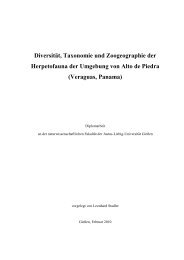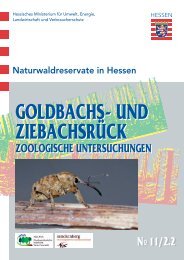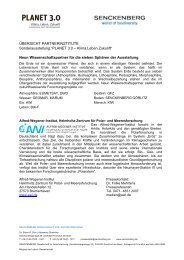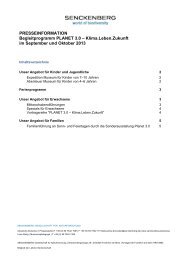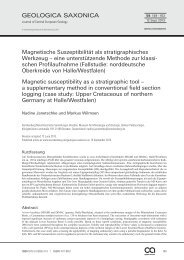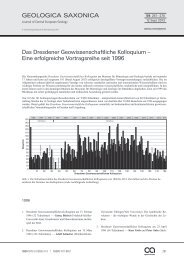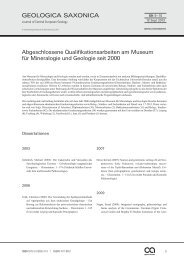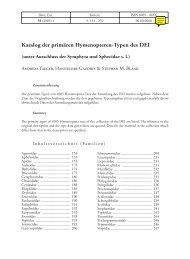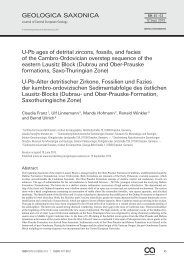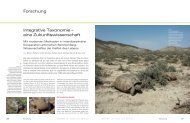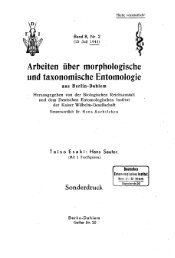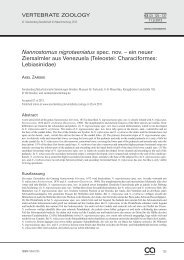Taxonomic publications: past and future - Senckenberg Museum
Taxonomic publications: past and future - Senckenberg Museum
Taxonomic publications: past and future - Senckenberg Museum
Create successful ePaper yourself
Turn your PDF publications into a flip-book with our unique Google optimized e-Paper software.
Burckhardt & Mühlethaler (eds): 8 th GfBS Annual Conference Abstracts 50<br />
Advances in phylogenetic inference from molluscan mitochondrial genomes<br />
Gerhard Steiner, Hermann Dreyer, Miriam Satler, Martina Knapp<br />
The use of complete mitochondrial genomes – both their nucleotide sequences <strong>and</strong><br />
the gene arrangements – for phylogenetic inference has steadily increased during<br />
the <strong>past</strong> years. Although the Mollusca are the most species-rich phylum second to<br />
Arthropoda, there are only 20 complete molluscan mitochondrial genomes published<br />
compared to about 100 arthropod <strong>and</strong> almost 500 vertebrate genomes. This low<br />
number may result from peculiarities of molluscan mt-genomes that make them<br />
difficult to analyze. Genome size <strong>and</strong> gene order vary considerably among molluscs.<br />
Gene duplications <strong>and</strong>, at least in bivalves, heteroplasmy due to distinct female <strong>and</strong><br />
male mt-genome lineages (doubly uniparental inheritance) complicate template<br />
generation, sequencing <strong>and</strong> phylogenetic analyses. As a consequence, the<br />
molluscan taxon sample has been insufficient to recover plausible phylogenies from<br />
mt-gene order data. We present 12 additional mt-genomes, ten from Bivalvia <strong>and</strong><br />
one each from Scaphopoda <strong>and</strong> Caudofoveata respectively, with the main purpose to<br />
assess gene order variability within bivalves. The trees resulting from parsimony <strong>and</strong><br />
Bayesian analyses of amino acid sequence data show a well supported cephalopod<br />
clade but the other major taxa appear diphyletic. This is caused by the most basally<br />
branching species in each taxon, Nucula (Bivalvia), Haliotis (Gastropoda), <strong>and</strong><br />
Graptacme (Scaphopoda) clustering together with the polyplacophoran Katharina<br />
<strong>and</strong> the caudofoveate Chaetoderma at the base of the molluscan subtree. Similar<br />
topologies result from the parsimony <strong>and</strong> Bayesian analyses of gene order data with<br />
the same species in a basal position due to their conserved plesiomorphic gene<br />
order. The corresponding positions of these species in the amino acid <strong>and</strong> gene<br />
order trees suggest similar substitution <strong>and</strong> rearrangement rates. This is corroborated<br />
by the significant correlation of the relative change rates of both parameters, as has<br />
previously been shown also for mt-genomes of Hexapoda. With a near-plesiomorphic<br />
gene order present in most major molluscan groups, accelerated rearrangement<br />
rates must have arisen independently within each group. However, we can show that<br />
the improvement of the taxon sample increased the quality <strong>and</strong> reliability of<br />
phylogenies inferred from mt-genomes. Especially in fast evolving taxa as the<br />
bivalves, these data hold great promise to resolve their deep phylogeny when more<br />
mt-genomes become available.<br />
Supported by the Austrian Science Fund, FWF project P16954-B12.<br />
Org. Divers. Evol. 5, Electr. Suppl. 13 (2005)



